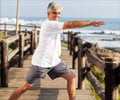Muscle regeneration promoted by aerobic exercise is mediated by changes in oxygen consumption by satellite cells, found researchers.

‘Adaptation of muscle tissue to aerobic exercise alters the metabolism of muscle stem cells, helping them recover from injury. Findings may contribute to treatment of cachexia, sarcopenia and other conditions associated with lean mass loss.’





The USP group found that aerobic exercise boosted the growth of satellite cells and that significant metabolic alterations lay behind the phenomenon. The study was conducted during the PhD research of Phablo Sávio Abreu Teixeira, with the support of a scholarship from São Paulo Research Foundation - FAPESP. "We noted reduced oxygen consumption in satellite cells, whereas exercise raised the demand for oxygen in all other muscle tissue. This is the first time anyone has managed to observe how aerobic exercise influences mitochondrial metabolism in these cells and how this affects muscle regeneration," Abreu told.
To understand the mechanism, Abreu conducted a number of experiments with animals at USP's Chemistry Institute under the supervision of Professor Alicia Kowaltowski, who has continuously studied mitochondria since the 1990s and is affiliated with the Center for Research on Redox Processes in Biomedicine (Redoxome), one of the Research, Innovation and Dissemination Centers (RIDCs) supported by FAPESP.
The findings are reported in an article published in Journal of Cachexia, Sarcopenia and Muscle. "We discovered at least part of the mechanism that led to improved muscle regeneration. Fuller knowledge is the first step to being able to intervene in the regeneration process in future," Kowaltowski said.
Several stages
Advertisement
At the end of this period the researchers tested the mice to see if the exercise had in fact improved their aerobic capacity. In the next stage, muscle tissue in both groups was injured and its regenerative capacity was analyzed.
Advertisement
After concluding that muscle repair capacity had improved, the researchers investigated the alterations to satellite cells isolated from the animals submitted to the exercise program. Proteins that regulate cell quiescence and activation, enabling self-renewal or differentiation, were augmented in these cells. "They also showed that differentiation had been inhibited, confirming our findings," Abreu said.
Satellite cells are responsible for muscle tissue regeneration and preservation, he explained, but to perform this function they have to remain quiescent in order to maintain tissue homeostasis. Throughout the subject's life, they are activated by injury or by wear-and-tear due to exercise. Some then differentiate into tissue cells, while others self-renew, giving rise to new satellite cells so that the cycle can continue.
"These cells are constantly activated, but over time they can become fatigued and stop self-renewing. This is what happens in muscular dystrophy and diseases involving loss of muscle mass such as cachexia or sarcopenia," Abreu said. "If we have more renewed cells, it means we have more cells capable of regenerating tissue."
In addition to concluding that exercise maintained muscle tissue regeneration capacity and contributed to recovery from injury, the researchers measured satellite cell oxygen consumption in search of an explanation for the phenomenon. "Surprisingly we found them to consume less oxygen, as if they had become more economical," Abreu said.
The findings refuted the researchers' initial hypothesis, which was that because aerobic exercise enhanced muscular oxidative capacity and satellite cells are anchored to the surface of skeletal muscle tissue (hence the name satellite), the oxidative capacity of satellite cells also ought to increase.
The role of mitochondria
Cellular respiration, the process by which chemical energy is released during the oxidation of organic molecules, occurs in mitochondria, organelles thought until recently to be responsible only for energy production. "Scientists have increasingly discovered the extent to which mitochondria are involved in various other processes," Kowaltowski said.
To confirm that mitochondrial oxygen consumption did indeed explain satellite cell self-renewal, Kowaltowski and Abreu performed two more experiments, using drugs to mimic the effect of reduced oxygen consumption on cells grown in the laboratory, and transplanting cells from exercised mice into sedentary mice. The reduction in oxygen consumption was indeed found to enhance satellite cell self-renewal. The rate of repair did not change in transplanted cells, but inflammation diminished, suggesting enhanced muscle recovery.
The researchers now plan to investigate the effects of reduced mitochondrial oxygen consumption and the pathways involved in satellite cell self-renewal. "In short, we need to understand why inhibition of cellular respiration enhances muscle recovery," Kowaltowski said.
It may be possible to replicate this phenomenon in future to treat age-related loss of muscle mass or the same problem resulting from cancer. The process is currently irreversible in many cases.
Source-Eurekalert















